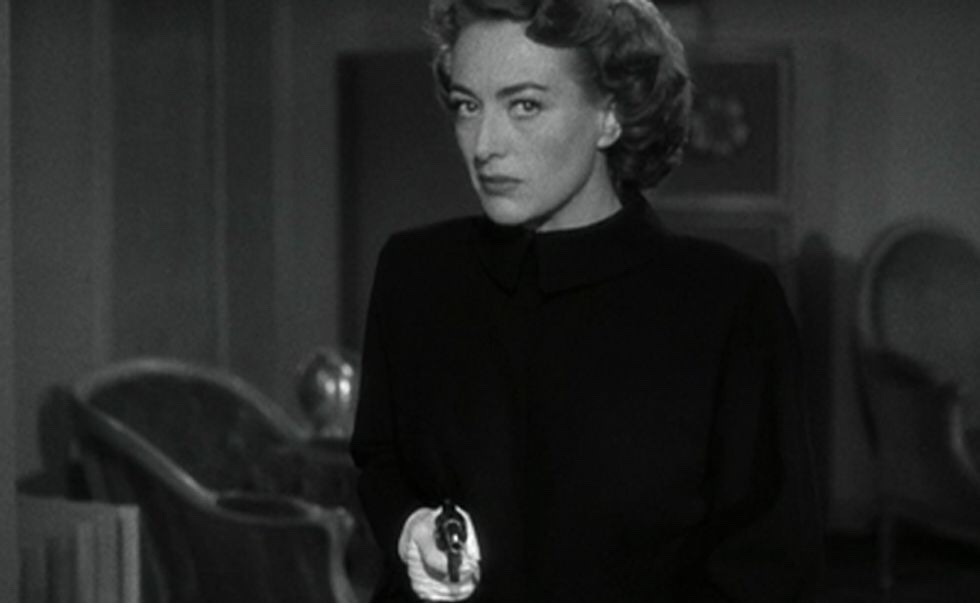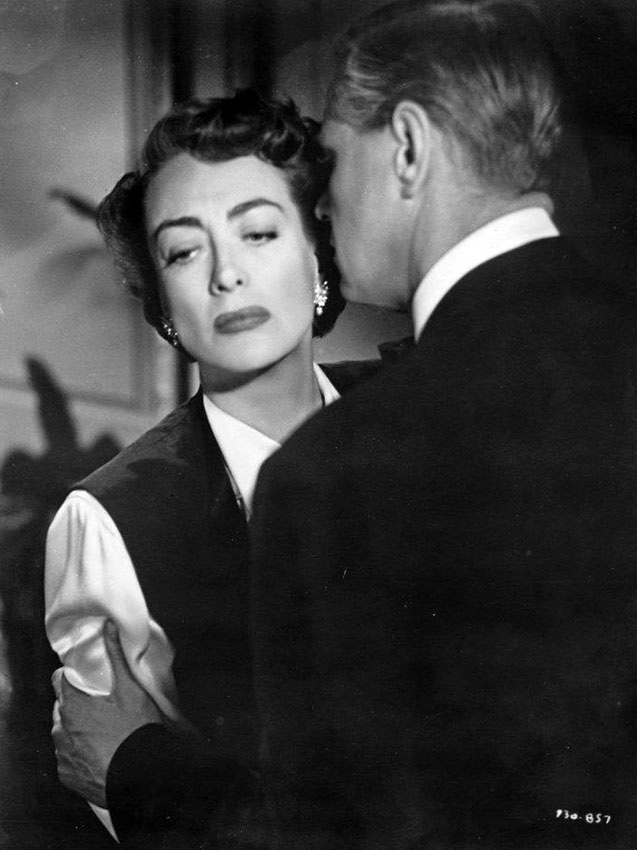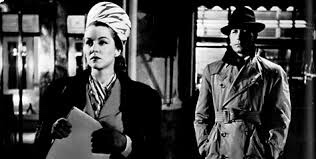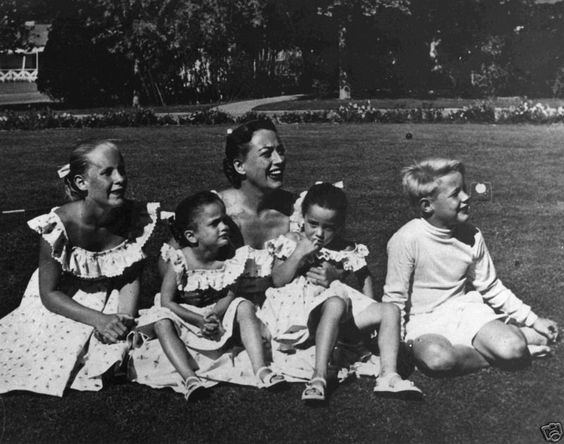
Film historian Charles Busch has called her “the ultimate movie star,” and to fans of classic film, Joan Crawford needs no introduction, but few might call the actress a queen of film noir. In fact, it wasn’t until she lost her eighteen-year berth at Metro-Goldwyn-Mayer, moving on to become a star at Warner Bros., that the actress began making these dark-themed tales so prevalent in post-World War America, and not until a reporter mentioned that Mildred Pierce belonged in this category had Joan even heard of film noir. It was a genre with which the actress would become intimately familiar, because, in the end, film noir pulled Crawford’s career from the bottom of the Hollywood heap to the dizzying heights of Mount Everest.
Like many of the down-on-their-luck-but-grasping dames who inhabit film noir, Joan Crawford came from nothing to get her hands on considerable wealth and power by dent of innate intelligence, boundless ambition, and considerable physical magnetism. Born Lucille LeSueur in San Antonio, Texas, to a mother who didn’t really want her and a father who abandoned her as an infant, Lucille learned early on that the only person she could truly depend on was herself. After being sent off to a couple of boarding schools to keep her away from her mother’s succession of deadbeat boyfriends and husbands, Joan found work in a department store and then as a dancer in the chorus of a Chicago nightclub, where she caught the eye of Broadway producer J.J. Shubert by ensuring that a drink landed in his lap when she danced by his table. Shubert was impressed enough by the “little fat girl with the big eyes” to give her a job in the chorus of a couple of his shows, and when MGM producer Harry Rapf saw Lucille dancing across the stage in Innocent Eyes, he thought she “had something.” By landing in his bed, the canny young woman landed herself a screen test and then a contract at the most prestigious movie factory in the world.
After almost two decades as one of Metro’s major stars, Joan began losing all the best female roles to the likes of Lana Turner and Greer Garson and was stunned when studio head L.B. Mayer agreed to let her out of her contract. But over at Warner Bros., mogul Jack Warner thought Crawford not only retained enough star power to light up movie screens for a few more years but also figured she could help him keep the troublesome Bette Davis under control, too. Joan signed a new contract at the more workman studio within days of losing her job at MGM, and after taking two years to search for just the right vehicle, nabbed the title role in Mildred Pierce, a part that would win her an Oscar and her first film noir role in a four-film cycle that would catapult her career into the Hollywood stratosphere more than once.
Mildred Pierce (1945)
“I felt as though I’d been born in a kitchen and lived there all my life, except for the few hours it took to get married.”
—Mildred Pierce
True to its film noir label, Mildred Pierce opens as its leading man is being peppered with bullets. But at its center, Mildred is a “women’s film,” tracing its heroine’s rise as a single mother selling cakes and pies in order to feed and clothe her two daughters, to waitress, and finally to a successful restaurateur with a string of white tablecloth chicken dinner establishments to her name. Along the way, Mildred is plagued by her obsession with playboy homme fatale Monte Beragon (Zachary Scott) and with her good-for-nothing daughter Veda (Ann Blythe), who turns out to be the femme fatale of the piece.
After her youngest daughter, Kay, dies, Mildred does everything in her power to give Veda the good life, including spending money she doesn’t have to buy and refurbish a mansion and marrying a man she doesn’t love, only to have Veda try to steal Monte from her and then ice him because he dares to reject her. Mildred tries unsuccessfully to take the rap for her daughter, of course, but when Veda ends up in the slammer anyway, Mildred, like most heroines of women’s pictures, decides to put her apron back on and remarry her first husband.
The key to her success in this role lies in the fact that Crawford is Mildred throughout much of the film. She becomes the self-sacrificing mother and entrepreneur—a feat the actress didn’t often achieve in many of her other vehicles.
Although there are some moments when she’s required to be tough and demanding, Mildred is one of the last films in which Crawford imbues her character with an almost overwhelming vulnerability—a vulnerability that serves the self-immolating motherhood she portrays very well. It isn’t until Veda confronts her mother about degrading the family by daring to support her daughters as a waitress that Joan allows the hard edges that would dominate her later films to appear for the first time. She lets Veda have it, declaring that she did the only thing she knew how to so that her daughters could “eat and have a place to sleep and some clothes on your backs.” Then, in a burst of creativity, Mildred comes up with an idea designed to placate her selfish daughter—she is only working as a waitress to learn about running a restaurant from the ground up with an eye to eventually owning one of her own!
Later, in a clash over Veda’s blackmailing her husband with a false pregnancy, Crawford gives in to her usual stony anger completely, ordering her conniving daughter to “get out before I kill you,” essaying only a thin veneer of the all-forgiving motherly love her character is supposed to feel for Veda—a definite hole in an essentially seamless performance.
In contrast, Mildred’s reaction to her youngest daughter’s death is oddly restrained. Crawford accurately portrays the shock any parent must feel over the death of a child, and her manner is quiet and tender when she explains to her ex-husband that she had to marry Monte Beragon for the social status he represents, in order to try and win Veda back. Her reunion with her wayward daughter is filled with forgiveness and warmth. Crawford says her daughter’s name just once when she sees her for the first time after months apart, and we hear all the love that she has been storing up for her child in her voice.
Possessed (1947)

“Something happens to a woman when she isn’t wanted—something dreadful.”
—Louise Howell
Possessed is a darkly intricate tale of obsession and madness that speaks to the then-moviegoing public’s fascination with the psychiatric goings-on in a fragile mind. Only getting her hands on the part of the mentally unstable Louise Howell because her Warner Bros. nemesis, Bette Davis, was out on maternity leave, Joan bites down on the role with obvious relish.
The film opens on a nearly catatonic Louise as she wanders through the early morning streets of Washington D.C., searching for someone named David. As she is wheeled into the psychopathic department of a local hospital and pulled out of her catatonic stupor by a miracle drug, Crawford’s Louise is incredibly fragile, much like a lost child.
Louise’s obsessive love story is told in flashbacks, beginning with her life as a nurse caring for the emotionally unsteady Pauline Graham. Louise is deeply in love with a less than enthusiastic rascal of an engineer named David Sutton (Van Heflin), and despite begging him to take her along, David blithely chooses to move to Canada alone. She is so unsettled by his rejection that when the suicidal Pauline Graham drowns herself in the lake on the family estate, Louise is sure she is responsible, until her boss, the sympathetic and wealthy Dean Graham (Raymond Massey), reminds her that she wasn’t even at the lake house when his wife killed herself.
With no charge to take care of, Louise is set to leave when Dean asks her to stay on as his son’s nanny and, later, to be Mrs. Graham. Feeling nothing much for Dean, Louise decides to say yes because she is lost and has no other place in the world, but the delicate balance of her precarious existence is thrown into disarray when David returns as an uninvited guest at her wedding, compounding his sin by coming on to Louise’s pretty stepdaughter, Carol (Geraldine Brooks).
Insanely jealous, Louise has hallucinations of pushing Carol down a flight of stairs to her death, and Dean decides to take his wife to the lake house for a rest. In Louise’s confused mind, the house is haunted by the ghost of the first Mrs. Graham, and Crawford’s terror at hearing Pauline Graham’s bell summoning her to the sickroom is something to behold. Her bloodcurdling screams rip through the murky house as the delusional Louise “sees” Pauline telling her to kill herself, just as she thinks she helped her mistress commit suicide two years ago.
Encountering the dead Pauline around every dark corner, Louise begs Dean to go back to town, where the two find David and Carol discussing matrimony. Because David is no good for Carol and, more accurately, will have nothing to do with Louise, she puts a gun in her purse and confronts the bastard, shooting him dead and then wandering the rain-wet streets looking for him. Thankfully, Dean promises to stand by his wife no matter what.
Joan’s portrayal of Louise is nearly flawless, garnering her an Oscar nomination for a performance that is more nuanced than Mildred. In an amazing display of encroaching instability, the actress scatters her words hesitantly like pebbles on a beach, cutting her eyes back and forth feverishly, hinting at the paranoid fantasies that have taken root in her brain. When Louise loses the slimy David, she’s heartbroken, and this is one time that Crawford’s tendency to sob uncontrollably serves the role well. As with many who experience mental illness, Louise’s moods swing from one pole to another, both laughing and crying at Dean Graham’s marriage proposal. She’s also plagued by visual and auditory hallucinations ingeniously displayed.
Crawford treats viewers to a stunningly manic diatribe about David and his secrets, letting her stepdaughter know that David is in love with her, not Carol. Joan fittingly ends the tour de force performance with the unhinged realization that her former lover is dead and she’s the one who killed him.
The Damned Don’t Cry (1950)

“He’s promised me the world, Marty, and I have to have it.”
—Ethel Whitehead
As with many a film noir, The Damned Don’t Cry opens with the discovery of a dead body, and, in the initial scenes, Crawford manages to get out of her own way, truly embodying a worn-out, dead-tired Lorna Hansen Forbes on the run from the mob. As in Mildred Pierce, Joan plays another self-sacrificing mother, but this time when her child dies tragically, she has no other with which to be obsessed, becoming preoccupied with self-improvement and grasping the good things in life instead.
After the death of her little boy, Joan leaves her husband and parents and their bare-bones existence to move to California, initially becoming a dress model in a second-rate dress mill and then a gangster’s moll. Immediately, she is the Crawford we recognize—smartly, if inexpensively dressed, flirtatious, knowing and hard around the edges—that is, until a mountain of dirty cash and a high-society mentor smooth out her rough edges and turn Ethel Whitehead into Lorna Hansen Forbes, a “learned” lady.
When she finally makes her entrance as Mrs. Forbes, Joan is her usual Lady Bountiful self, her tones dulcet, as polished to high gloss as her nails, and haute coutured. Perfectly comfortable in her new role, she invites her guests into her beautifully appointed drawing room and orders her butler about as if she were to the manner born.
Unfortunately, Joan is up to her usual overemoting tricks and is far too arch in her as Lorna when she tries to seduce Steve Cochran’s Bugsy Siegel-like gangster in order to get dirt on him at the request of her lover, mob boss George Castleman (David Brian). But when she is beaten up by her jealous sugar daddy while pleading for Cochran’s life, her tears seem genuine.
In typical noir fashion, the story ends when Castleman shows up at Ethel’s parents home to gun her down, and she takes a bullet but survives to strive another day.
Sudden Fear (1952)
“Without you, I have nothing.”
—Myra Hudson
After getting axed from Warner Bros., Crawford found that her career was again hanging by a thread when an offer came to do a noir thriller called Sudden Fear for an independent production company. Joan jumped at the chance, and her choice proved a wise one because the film was a gigantic hit, handing the actress another Oscar nomination.
Sudden Fear is the story of wealthy playwright Myra Hudson and her unfortunate marriage to the strangely handsome but menacing actor she had fired from one of her plays. To get even, Lester Blaine (Jack Palance) seduces the initially wary older woman into marriage and then proceeds to plot her murder with the help of his beautiful girlfriend, Irene (Gloria Grahame). The two decide to get rid of the much-older bride when they find out that Myra is leaving her husband a relative pittance in her new will, and they plan to off her before she can sign the offending document.
Fortunately for the beleaguered Myra, she finds out about her husband’s murderous plan, coming up with a scheme of her own, and in a convoluted plotline worthy of Hitchcock, she poses as an Irene look-alike with the intent of offing her husband and putting her competition solidly in the frame. But when push comes to shove, Myra can’t bring herself to shoot Lester. As Irene leaves Lester’s apartment after he’s a no-show for the meeting Myra arranged, Lester runs his girlfriend down on a rainy San Francisco street, mistaking her for his wife. The dastardly pair both die in the resulting crash, leaving Myra to face her brave new life alone.
Crawford attacks the role of Myra Hudson with her usual “actressy” intensity—overplaying when she should be underplaying—a sure sign that Miss Crawford’s wishes reigned supreme during filming, probably because she was an uncredited producer on the project.
Joan’s supporting cast couldn’t get any better than this one, including the hatchet-hewn handsomeness of Palance (who fairly oozes his particular brand of danger throughout), along with the ripely lovely but grasping Grahame. Betraying her advancing age, Joan’s lovely face sports the look of perpetual surprise often worn by actresses of a certain age who have just been under the surgeon’s knife.
Surgically treated or not, Crawford emotes all over the place—her huge eyes darting up and down and overflowing with tears she can’t hold back as she learns that the young husband she adores never loved her for a moment and that he and his sexy girlfriend are planning to do away with her. Overacting her sense of terror at the prospect and vowing to get even, Joan attacks the scene with all the subtlety of an opera diva on opening night.
The actress does a much better job portraying Myra trying to keep a lid on her fears while fooling her husband into believing that everything is fine. Crawford is particularly good a sequence in which she sees her face in the mirror at Irene’s apartment while she awaits Lester’s arrival—her gloved hand clutching a gun, her eyes reflecting her inner struggle beautifully. She overdoes the sobbing fear that fills her as Lester enters, but what follows is one of the finest cat-and-mouse sequences ever put on film, as Myra hides in a closet while watching her husband through the slits in its closed lattice doors. Lester looks directly at his wife without seeing her at one point, and the rawness of the terror in Joan’s eyes is chilling.
Despite their unevenness, Crawford’s collection of film noir offerings can be pointed to as some of her most solid performances in a long and often stellar career, with the veteran actress’s tendency to convey raw emotion and overact working in her favor in many of these dark, turgid tales.














































